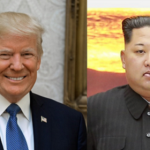President Trump spoke about the possibility of a ‘major, major conflict’ with the Democratic People’s Republic of Korea (DPRK) at the United Nations General Assembly in September 2017. He matched Pyongyang’s threats and pushed the United Nations Security Council to impose a series of debilitating sanctions on it. Yet in March 2018, Trump agreed to a summit meeting with DPRK leader Kim Jong-un. This will be a historic first – if it does happen.
What role did Beijing, Pyongyang’s sole patron, play in brokering this unprecedented thaw? Why did Kim Jong-un suddenly decide to smoke the peace pipe? Did agreeing to a summit represent a cave-in by Trump or fruition of his game plan?
China regards the DPRK as a buffer state, provides it political protection and serves as its economic lifeline. Over 90% of DPRK’s trade is with China. Tens of thousands of North Koreans work in China, sending back remittances that their country badly needs. But relations have been strained ever since 2011, when Kim Jong-un assumed power. Disregarding Chinese counsel, he developed Weapons of Mass Destruction (WMD), putting his ally under international pressure. Beijing was also arm-twisted by Washington into endorsing UN and American sanctions on Pyongyang. Bilateral ties were hit further after Kim Jong-un had his uncle, Jang Sung-taek, who was close to Beijing, publicly purged and executed in December 2013 allegedly for economic corruption.
The sudden thaw in inter-Korean ties took Beijing completely by surprise. Summits between Kim Jong-un and South Korean President Moon Jae-in as also Trump were announced in quick succession. China which claims primacy in the Korean Peninsula saw itself sidelined, with Kim, Moon and Trump setting the agenda. President Xi quickly went all out to woo Kim[1], inviting him for summits in Beijing (March 25-26) and Dalian (May 7-8). Beijing wanted to be back in the reckoning and Pyongyang was keen to enhance its advantage with Seoul and Washington. Thus, at least for the present, Beijing cannot claim much credit for the thaw in the Korean Peninsula though it retains the ability to complicate any deal, given DPRK’s dependence on it and its ability to circumvent sanctions.
Kim Jong-un’s unexpected offer on 1 January 2018 to make peace and hold dialogue with South Korea showed his nimble-footedness and the requisite guile, imbibed from his forebears. He weathered the sanctions, acute economic hardship and international isolation to develop nuclear and missile deterrents against possible U.S.-led aggression. Mission complete, he expeditiously shifted gears. That Moon, a steadfast votary of rapprochement with DPRK, was in office (since May 2017) helped. In July 2017 he outlined a peace plan at Berlin,[2] seeking neither regime collapse nor an artificially expedited unification with the North. It greatly displeased Washington.
President Trump, who too has caused displeasure to friend and foe alike in his disdain of the established order ever since occupying the White House, was craving a major foreign policy success, and there could be no better prize than the DPRK, a nation that has been a bane of American diplomacy for decades. The threats notwithstanding, Trump also signalled his willingness to meet Kim ‘over a hamburger’ last year.
The meat of the matter, though, lies elsewhere. North Korea did suspend all missile and nuke tests and express readiness to denuclearise provided the security of its regime was guaranteed. But the U.S. and DPRK differ on the scope, extent, pace and sequence of the denuclearisation process. Washington seeks ‘Complete, Verifiable and Irreversible Denuclearisation’ (CVID) upfront. This may be a deal breaker as Kim will not give up his only trump card. He has also studied the fate of Qaddafi and Saddam Hussain. DPRK is now a de facto nuclear power: history has not seen such a one disarm. Short of CVID, DPRK will agree to almost any arrangement, including a programme-freeze under UN or International Atomic Energy Agency safeguards in return for massive economic assistance.
The DPRK’s threat last week (May 16)[3] to pull out of the scheduled June 12 summit with the U.S. should be seen in this context. National Security Adviser John Bolton’s proposal of a Libya-type solution for DPRK’s nuclear programme put a spoke in the proceedings. Similarly the resumption of joint military exercises by the U.S. and South Korea, which are perceived as a threat, did not sit well with the DPRK. It will not accede to the U.S.’ terms solely. If Trump and his team expect it to succumb to economic inducements and barter away its weapons arsenal, they are perhaps mistaken.
All parties need to be sensitive to one another’s concerns, or else the current thaw – like the shift in seasons – may not last long.
Vishnu Prakash is former Indian Ambassador to Seoul.
This article was exclusively written for Gateway House: Indian Council on Global Relations. You can read more exclusive content here.
For interview requests with the author, or for permission to republish, please contact outreach@gatewayhouse.in or 022 22023371.
© Copyright 2018 Gateway House: Indian Council on Global Relations. All rights reserved. Any unauthorized copying or reproduction is strictly prohibited.
Reference
[1] Xiangwei, Wang, ‘Kim’s international bdebut in Beijing’, The Korea Times, 24 May 2018, <http://m.koreatimes.co.kr/phone/news/view.jsp?req_newsidx=246547>
[2] Hyun-jung, Bae, ‘Full text of Moon’s speech at the Korber Foundation’, The Korea Herald, 7 July 2017, <http://www.koreaherald.com/view.php?ud=20170707000032>
[3] Press statement from the first Vice-Minister of Foreign Affairs, Korean Central News Agency


